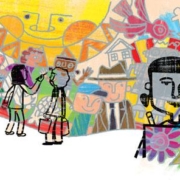Guiding Our Students’ Future in Science & Technology
By Sima Misra, Director of Teaching & Learning
Many of you know our school’s mission by heart: “Ignite curious minds, awaken generous hearts, engage a changing world.” That lays out a path to guide our students’ future. We have two vision statements that help us picture aspects of our destination: our Science Vision and our Technology Vision.
TBS Vision for Science & Tech Education
Our Science Vision guides our teaching of science and engineering. Its goal is to inspire and lay a path to enable all our students to be responsible, scientifically literate citizens who recognize challenges and opportunities facing our modern world.
Spearheading the drafting and implementation of our Technology Vision is our EdTech Specialist Susan Winesmith, who coordinates closely with Loa Ortiz in leading the Info Literacy/Tech team (Librarian Rebecca Greco, IT Director Jose Arellano, and myself) and the technology arm of the ECC-8th grade Science & Technology committee.
Recently, we shared our new Technology Vision, guiding not only the teaching of technology skills and habits necessary for 21st century learners, but also how we think about technology at TBS and the ways that teachers, students, and staff use technology to enhance instruction, express themselves creatively, solve problems, and support family-school partnerships. These vision statements also provide us with concrete ways to prepare students to become civically engaged citizens capable of addressing society’s challenges.
Our Path
We began a partnership with BaySci in 2015: since then, that organization has provided K-8 science teachers with ongoing professional development to cultivate students’ skills in research-based Next Generation Science Standards (NGSS) science and engineering practices (such as asking questions and defining problems, engaging in argument from evidence, and applying mathematics and conceptual thinking).
NGSS-connected professional development has also helped us solidify students’ understanding of “crosscutting” concepts, such as:
- cause & effect,
- identifying patterns,
- and scale & proportion.
As well as disciplinary core ideas like:
- earth & space,
- life,
- physical sciences,
- and engineering.
This October we sent our Middle School science teachers Loa and Jeff to the California Science Teachers Association conference to learn more about best practices in science and engineering teaching and learning. They attended workshops on everything from Earth Science to Engineering, and were excited to bring their new knowledge and insights back to their colleagues on the ECC-8th grade faculty Science & Technology committee. For the second year, Loa is facilitating this group in ongoing work to align the K-8th grade NGSS performance expectations with the current TBS science learning outcomes and assessment practices. This work has been supported by providing each K-5 class with a second Full Option Science System (FOSS) unit, a research-based science curriculum for grades K-8 developed at the Lawrence Hall of Science.
TBS Science Curriculum
Our elementary classrooms now teach the following FOSS units:
- K: Forces & Motion; Animals Two by Two
- 1/2: Plants & Animals; Solids & Liquids; Pebbles, Silt & Sand
- 3: Water & Climate; Motion & Matter
- 4/5: Energy; Earth & Sun; Chemistry (Mixtures & Solutions); Living Systems
Both 1/2 and 4/5 classrooms alternate science topics from one year to the next, so that all students receive the equivalent of a complete 1/2 or 4/5 grade science education after two years in the class.
In 6th grade this year, students will demonstrate their learning of earth science in one NGSS-aligned unit by designing a method for monitoring and minimizing human impact on the environment. And 7th and 8th graders are introduced to units by trying to figure out a puzzling, compelling phenomenon, which increases engagement by making science relevant. For example, to introduce density, students puzzle out why a lime sinks but a lemon floats in a tank of water.
TBS Tech Curriculum
Susan teaches a trimester of Digital Citizenship classes in 3rd through 8th grades that emphasize the safe and responsible use of technology, as well as Keyboarding and Introduction to Technology classes in 3rd through 6th grades to give students basic skills with Chromebooks, iPads, and software (such as the Google G Suite for Education) that supports their learning. These curricula resulted from research and surveys by last year’s Science & Technology team, incorporating standards from the International Society of Technology in Education that faculty identified as key for TBS students.
A vital aspect of our Technology Vision is supporting parenting adults in navigating the digital landscape with their students. Toward that end, we hosted two Family Ed events this fall, one for adults with Ana Homayoun, author of Social Media Wellness: Helping Tweens and Teens Thrive in an Unbalanced Digital World, and one for 4th-8th grade students and their families led by child and adolescent psychiatrist Dr. Jessica Lee and Susan Winesmith addressing questions about family media agreements, privacy and video game use. Ana Homayoun also recommended a new book to parents of children from birth through age 8, The Art of Screen Time: How Your Family Can Balance Digital Life & Real Life by Anya Kamenetz.
Recommended Educational Apps
At our recent Academic Excellence Coffee, parenting adults asked which online educational resources and apps we recommend, as it can be difficult to identify high quality ones. Here are some we currently use at TBS and recommend:
- Lexia Core 5, Raz Kids, and the One Minute Reader app in K-5 reading,
- Rockalingua (login: TBS, password: spanish); Pictocuentos; Basho & Friends; and Storybird in Spanish,
- Quizlet in 4th-8th Spanish, Spelling, and Humanities,
- Khan Academy (particularly for practice linked to 4th-8th grade MAP assessment results), Wuzzit Trouble, Base Ten Blocks Math, and MathTappers: Find Sums in math.
We also recommend DragonBox Math and DreamBox for math learning at home. Many of these resources provide engaging and fun ways for students to practice skills. If you have questions about how we use these tools, please let us know–we are happy to tell you more. Thank you very much for your partnership in service of your children’s learning.

